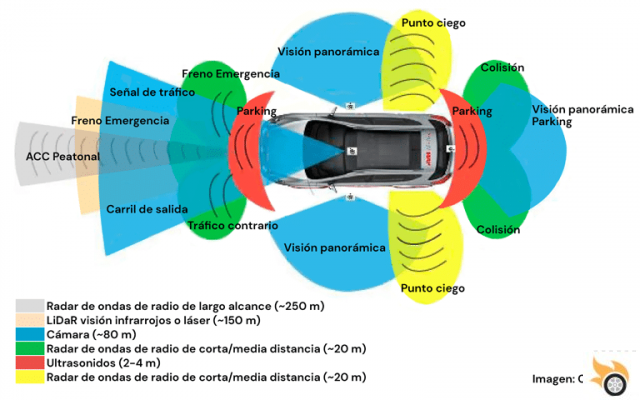
Welcome to Pistonudos.com, where we are passionate about the automotive world and we are committed to providing you with relevant and updated information. On this occasion, we are going to talk about ADAS systems, a technology that is revolutionizing the way we drive and that the General Directorate of Traffic (DGT) is promoting to improve road safety.
What are ADAS systems?
ADAS systems, acronym for Advanced Driver Assistance Systems, are a set of technologies designed to assist the driver while driving. These technologies use sensors and cameras to collect information from the environment and the vehicle, and then process it to provide the driver with warnings, assistance and, in some cases, even automatic intervention in risky situations.
How do ADAS systems work?
ADAS systems use a combination of sensors, cameras, and advanced algorithms to constantly analyze the environment and driver actions. These systems can detect obstacles, pedestrians, traffic signs, and other vehicles, and alert the driver to potential hazards. In addition, some ADAS systems can automatically intervene to avoid collisions or mitigate their consequences.
For example, the automatic emergency braking system can detect a possible collision and apply the brakes automatically if the driver does not react in time. Another example is adaptive cruise control, which automatically adjusts vehicle speed to maintain a safe distance from the vehicle in front.
How do ADAS systems help driving?
ADAS systems have as main objective to improve road safety and reduce traffic accidents. These technologies can help the driver in various situations, such as:
- Warn the driver about possible collisions or dangers on the road.
- Attend parking and lane change maneuvers.
- Control speed and keep a safe distance from other vehicles.
- Alert the driver to fatigue or distraction.
- Provide real-time information on road status and traffic conditions.
These driving aids can be especially useful in situations of heavy traffic, adverse weather conditions or on unfamiliar roads. In addition, ADAS systems can also contribute to more efficient and environmentally friendly driving by optimizing fuel consumption and reducing emissions.
Why does the DGT use ADAS systems?
The General Directorate of Traffic (DGT) has recognized the potential of ADAS systems to improve road safety and reduce traffic accidents. For this reason, it has promoted their use and established regulations that encourage the incorporation of these technologies in vehicles.
The DGT considers that ADAS systems can be an effective tool to prevent accidents and save lives. According to data from the DGT, 90% of traffic accidents are caused by human errors, such as distractions, speeding or lack of attention. ADAS systems can help mitigate these errors and avoid risky situations.
In addition, the DGT has also established the zero objective, which seeks to reduce the number of fatalities in traffic accidents to zero. ADAS systems are a key piece in the DGT's strategy to achieve this objective, since they can prevent collisions and minimize the consequences of accidents.
Zero target and ADAS systems
The zero objective is an ambitious but necessary goal to guarantee road safety. The DGT works on different fronts to achieve this objective, and ADAS systems play a fundamental role in this strategy.
ADAS systems can help reduce the severity of accidents and save lives by preventing collisions or mitigating their consequences. These technologies can alert the driver to potential hazards, assist with difficult maneuvers and, in some cases, even intervene automatically to prevent accidents.
It is important to note that ADAS systems do not replace the responsibility of the driver, but rather assist the driver and provide additional information to make safer decisions. The driver remains ultimately responsible for driving and must be vigilant at all times.
Frequently Asked Questions (FAQs)
1. Are ADAS systems required on all vehicles?
No, ADAS systems are not currently required on all vehicles. However, the DGT has established regulations that encourage their incorporation and more and more manufacturers include them as standard in their most recent models. It is expected that in the future these systems will become more and more common and will be present in most vehicles.
2. Are ADAS systems infallible?
ADAS systems are advanced technologies that have proven effective in improving road safety. However, they are not foolproof and may have limitations. For example, they may not work properly in extreme weather conditions or in heavily congested traffic situations. Furthermore, it is important to remember that the driver remains ultimately responsible for driving and must be vigilant at all times.
Conclusion
In short, ADAS systems are revolutionary technology that is transforming the way we drive. These technologies use sensors and cameras to assist the driver and improve road safety. ADAS systems can assist in a variety of driving situations, such as warning of potential hazards, assisting in maneuvering, and controlling speed.
The DGT has recognized the potential of ADAS systems and promotes them as an effective tool to prevent accidents and save lives. These technologies are part of the DGT's strategy to achieve the zero objective, which seeks to reduce the number of fatalities in traffic accidents to zero.
At Pistonudos.com, we care about road safety and we believe in the potential of ADAS systems to improve it. What do you think about these systems? Have you had any experience with them? Leave us your comments and share your opinions!
Until next time, and remember to always drive safely!


























